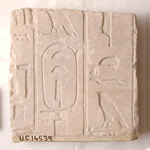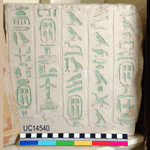| Homepage | Timeline | Maps | A-Z index | Learning |
Pyramid Texts
Modern name for the corpus of formulae inscribed in the inner chambers of late Old Kingdom (about 2686-2181 BC) pyramids; the earliest example is the pyramid of Unas. In later periods some of these compositions continued to be used in ritual, and were sometimes copied as funerary texts (Forman/Quirke 1995: 183)
(Unas, Teti, Pepy I, Merenre, Pepy II, Ibi) and in the pyramids of the queens of Pepy I and Pepy II.
|
UC 14539 (Teti)
|
UC 14540 (Pepy
I)
|
 |
 |
In the First Intermediate Period and in the Middle Kingdom (about 2025-1700 BC) formulae from this corpus are also found in burial chambers of high officials and on many coffins.
Some formulae from the Pyramid Texts are still in use in the New Kingdom (about 1550-1069 BC) and in the Late Period.
Among the extensive bibliography on Pyramid Texts, note in particular the following:
|